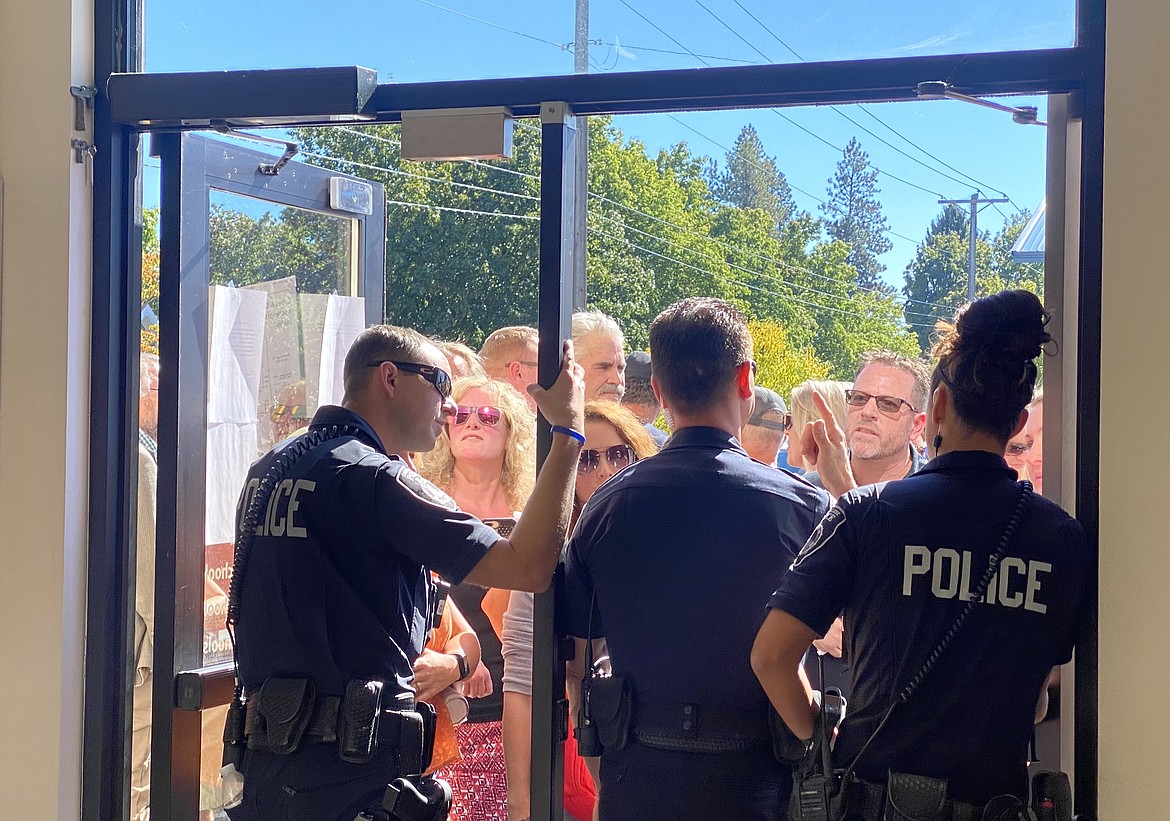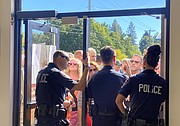How did we get here?
AUDREY DUTTON/Idaho Capital Sun | Coeur d'Alene Press | UPDATED 3 years AGO
Editor’s note: This is the first story in a series on health misinformation, vaccine hesitancy and distrust in Idaho. The Idaho Capital Sun interviewed dozens of people, asking how the state ended up on a path to catastrophe — and what, if anything, can turn it around.
State legislators, public health officials, lawyers, health care workers and a media scholar all described one common theme: distrust, fueled by forces within Idaho and beyond.
Coming Thursday, a look at how deregulation in Idaho has affected public health.
Fred Wood trained as a doctor in major medical centers. Then, he moved to Idaho in 1977 and spent the next few decades practicing modern medicine in a place where cows and sagebrush outnumber people — and where many of those people didn’t trust modern medicine.
“This is America. You do get to choose … for better or worse,” Wood said in an interview last month.
More than 40 years later, that distrust of modern medicine remains.
When the COVID-19 pandemic hit, Idahoans sought to make sense of a once-in-a-century threat. For some, the distrust left an opening that health misinformation rushed in to fill.
“Reliable information is strictly in the eye of the beholder,” Wood said.
Idaho now has one of the lowest coronavirus vaccination rates in the U.S., according to Centers for Disease Control and Prevention data.
More than 4,000 Idahoans have died from the disease, and nearly 414,000 cases have been reported in the Gem State.
Idaho’s hospitals teetered on the edge of collapse in crisis standards of care for three months. The Federal Emergency Management Agency sent in teams of nurses to help. Morgues ran out of space.
At that breaking point, Idaho Gov. Brad Little didn’t issue mask or vaccine mandates. He pleaded with Idahoans to choose to follow public health advice.
Some of them did. Many didn’t.
In the weeks following Idaho’s Sept. 16 statewide declaration of crisis standards of care, Idaho’s daily vaccine uptake fell.
“The Intermountain West, the Rocky Mountain West, it’s kind of the last of the Wild West, kind of the last frontier in the continental United States,” said Dr. Ted Epperly.
Epperly, who was born and raised in Idaho, runs the state’s largest residency for primary care doctors.
“People who migrated here (in the 1800s) wanted to get away from the government,” Epperly said.
“They wanted to be distanced and spaced, and they didn’t want people telling them what to do,” he said. “So it’s been a perfect breeding ground, I think, for that kind of libertarian thinking.”
Epperly also served on Idaho’s largest regional health board until this year, when county commissioners replaced him with a physician whose conduct and unsupported claims about COVID-19 drew numerous complaints to licensing boards.
ONE DOCTOR LEFT
The Idaho Legislature reconvened last month to consider a slew of bills related to COVID-19 and vaccines.
Rep. Wood, now retired from medicine, chairs the Idaho House Health and Welfare Committee and didn’t hold a single hearing on any of the bills.
The Republican from Burley is the only medical doctor serving in the Idaho Legislature.
“When I got to rural Idaho, it became apparent to me that there (were) a whole bunch of people getting medical care outside of traditional medicine,” Wood told the Sun in an interview last month. “I can’t tell you the number of people who, any time one of their kids got a cough, they would go out and load up a syringe with Combiotic, which was meant for the cattle.”
Wood, a retired physician, was one of few Republican lawmakers to follow public health recommendations for masks as the Legislature met in Boise. (Otto Kitsinger for Idaho Capital Sun)
Over the years, as a physician and a lawmaker, Wood came to realize that “a very significant minority” of Idaho’s population, as much as one-third of the state, avoids medical or osteopathic doctors.
Instead, many Idahoans seek out chiropractors or unlicensed naturopaths as their primary care providers. Some eschew any health care: Idaho’s faith healers rely on prayer.
THE WILD WEST
A segment of Idahoans rely on nontraditional “healing sources,” Epperly said. He considers those practitioners to be “kind of the snake-oil salesmen from the 1800s and early 1900s, that have found a foothold in our population.”
The pandemic only made it more obvious, he said.
“The national leadership during the pandemic was horrible, and it only served to sow the seeds of distrust,” Epperly said.
While Idaho’s independent, anti-government streak is part of the story, so are the kernels of truth and personal experiences that feed misinformation.
There are legitimate concerns about traditional medicine in the U.S. — the convoluted labyrinth of health care, the medical bills and bankruptcies, the examples of pharmaceutical companies making money off vulnerable patients, the rare incidents that cost a patient life or limb.
“Not everybody who goes into the hospital comes out alive. Not everybody who goes into the hospital gets the correct leg operated on,” Wood said. “And there’s just enough of that out there that people who don’t want to believe in traditional medicine can sink their teeth into …”
At a few points in the pandemic, the federal government and top public health officials undercut their own trustworthiness — in their messaging on masks, for example — several experts and health care providers said in interviews with the Sun.
The distrust of health authorities and the health care industry was on display when the Idaho Legislature met last month.
Health misinformation filled hours of public testimony on the bills.
One speaker said the COVID-19 vaccine “reprograms your immune system” — echoing a false claim propagated by Dr. Ryan Cole of Garden City.
One speaker said Idaho health care providers can vaccinate children at school without a parent’s permission, a false claim propagated by Health Freedom Idaho and debunked by the Idaho Director of Health and Welfare.
One speaker said there is “no vaccine in this world that can prevent you from getting a disease of any kind, of any shape.”
Many vaccines accomplish that goal and have for centuries.
THE SALK STORY
One of those vaccines has a back story in Idaho: the Salk polio shot. The vaccine is the reason polio is no longer a threat. The path to eradication, though, wasn’t perfect.
There was a time when polio killed and paralyzed thousands of Americans. Between 1951 and 1954, the Centers for Disease Control and Prevention reports polio killed 1,879 people and paralyzed 16,316 on average each year — many of them children.
The rollout of a vaccine in the mid-1950s was fast and aggressive, with children lined up to take the shots. Idaho Statesman newspapers from 1955 chronicled its progress in the Boise area, as parents rushed to sign up their children for inoculation.
One of the early manufacturers of the vaccine, Cutter Laboratories in California, inadvertently failed to kill the virus in its batches of polio vaccine. Federal health officials quickly put a stop to the Cutter-produced vaccine rollout, but damage was already done. (The COVID-19 vaccine does not contain the coronavirus, live or dead.)
The tainted vaccine harmed children in other states. But it hit Idaho disproportionately hard.
Ten people died as a result of the Cutter Incident, nationwide. Four of them were Idaho children — Janet Lee Kincaid of Moscow, Danny Eggers of Idaho Falls, Susan Pierce of Pocatello, Bonnie Gale Pound of Lewiston — according to books on the incident by Dr. Paul Offit, director of the Vaccine Education Center and physician in the Division of Infectious Diseases at Children’s Hospital of Philadelphia.
The contaminated vaccine doses from Cutter Laboratories sickened and paralyzed many more children in Idaho and beyond. It also shook the public’s trust.
Dr. Christine Hahn, Idaho state epidemiologist and medical director, believes the incident may have contributed to the vaccine hesitancy today.
“That runs deep,” Hahn said. “You know, if that was your grandma or your great uncle that got polio from a vaccine, that type of institutional memory stays in families for generations.”
Dr. Manley Shaw was an orthopedic surgeon in Idaho who recognized the early cases were “only the tip of the iceberg,” Offit wrote in his book “You Bet Your Life.”
“Shaw examined the medical records of more than four hundred school children from Pocatello, Boise, and Lewiston, and found that one of every three children injected with the two contaminated lots of Cutter’s vaccine” developed polio symptoms, Offit wrote.
Based on the number of polio vaccine doses shipped out from the California laboratory, Shaw’s findings meant about 40,000 children developing symptoms of the disease for which they’d been vaccinated, Offit wrote.
(Shaw happens to be the grandfather of Idaho’s public health administrator, Elke Shaw-Tulloch. She only recently learned of his role in restoring the polio vaccine’s safe rollout, she said.)
Offit said in an interview with the Sun that he’s not convinced the Cutter Incident played a direct role in Idaho’s vaccine hesitancy. He traveled here and spoke with Idahoans, and nobody seemed to recall the tragedy, he said.
“I don’t think that’s it. It’s all the other things. It’d be easier if it was that,” Offit said. “I think the reason Idaho is what it is, is (some Idahoans’ mindset of) government-off-my-back, rugged individualism, cowboy-ism.”
Still, even after 1955, when the Cutter Incident happened, parents didn’t stop vaccinating their children.
But this pandemic is different. Idaho is different.
Over the past decade, interest groups organized to push back against vaccination. Idaho became a beacon for medical freedom. And government leaders slowly loosened the guardrails meant to protect the public.




